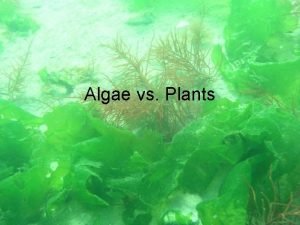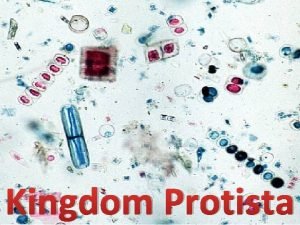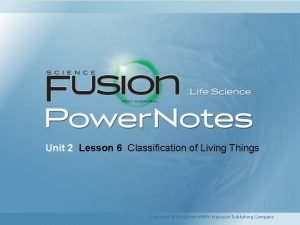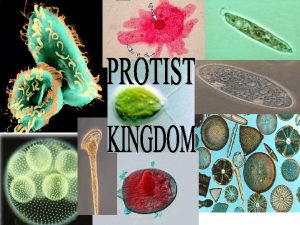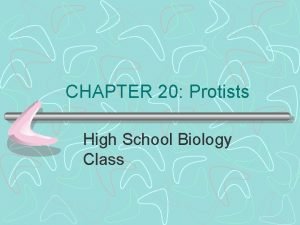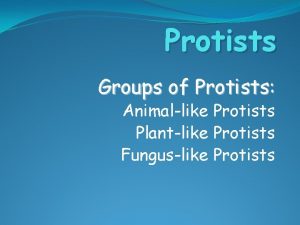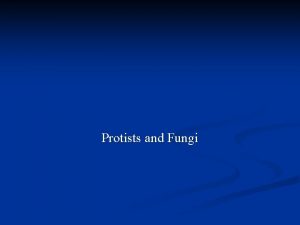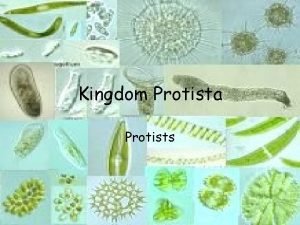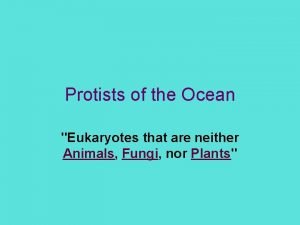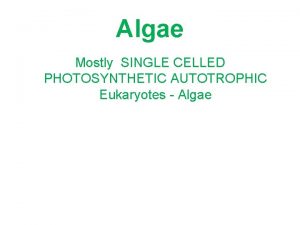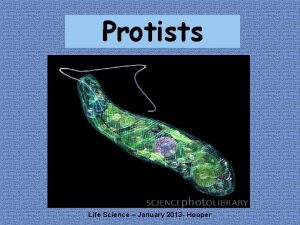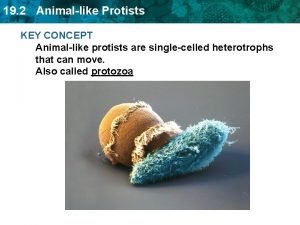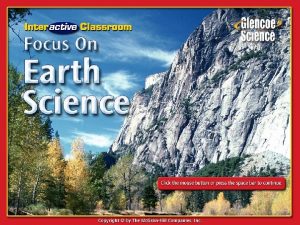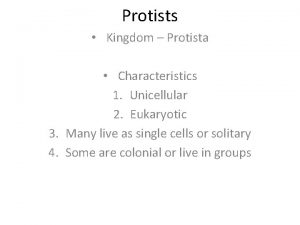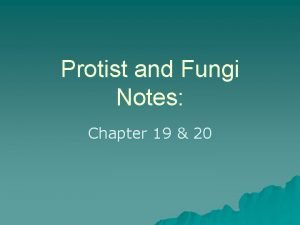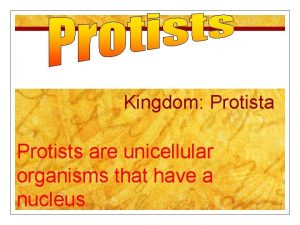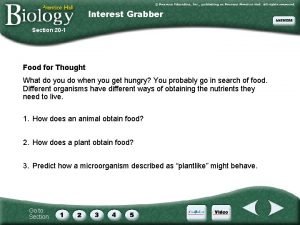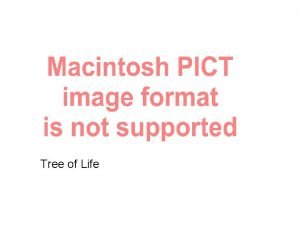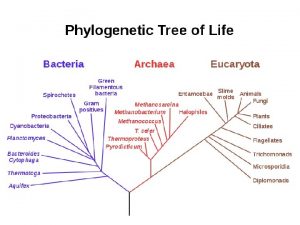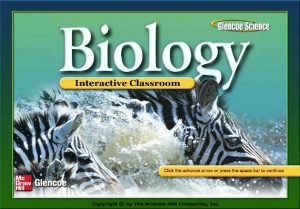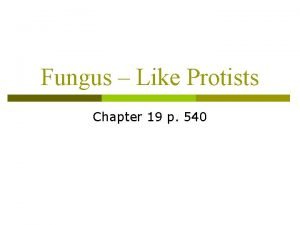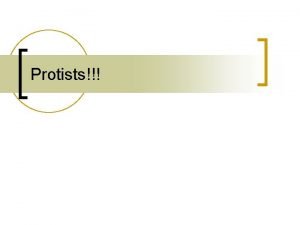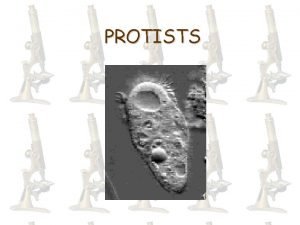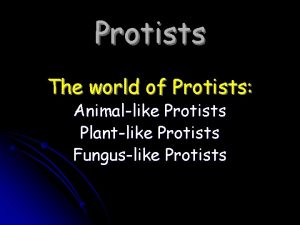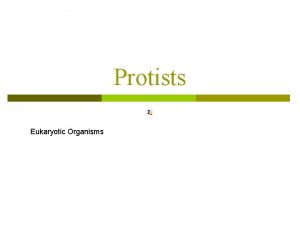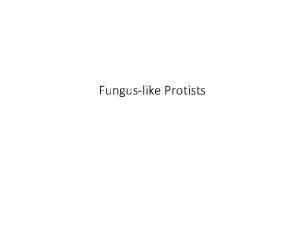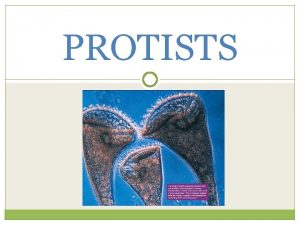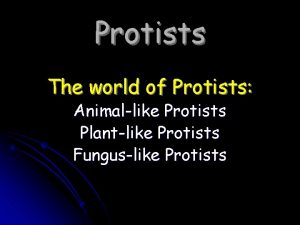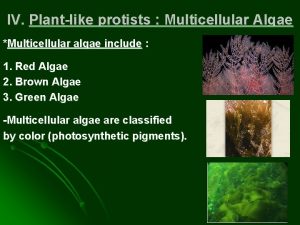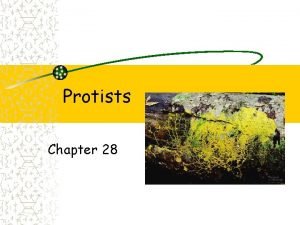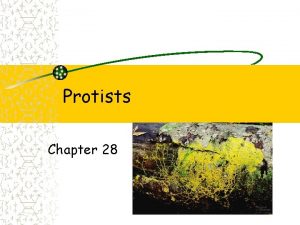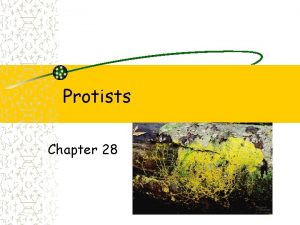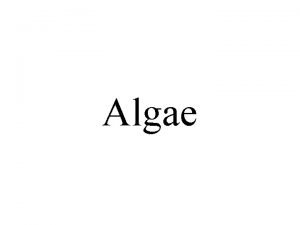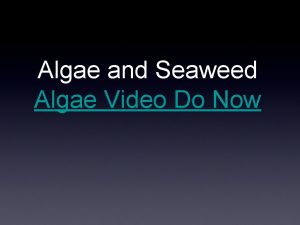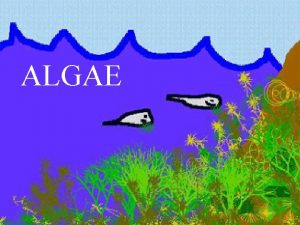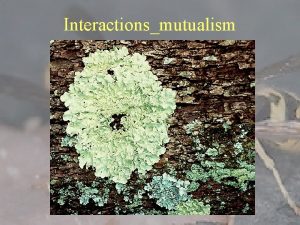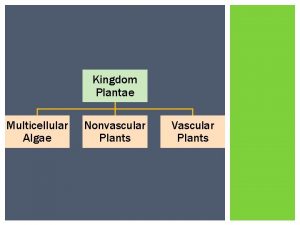Algae vs Plants What are algae Photosynthesizing protists

































- Slides: 33

Algae vs. Plants

What are algae? • Photosynthesizing protists. • All contain up to 4 kinds of chlorophyll. • Unicellular and multicellular.

3 Types of Unicellular Algae 1. Euglenoids • Plantlike in that most have chlorophyll and photosynthesize. • Lack a cell wall made of cellulose: made of a protein called a pellicle. • They use their flagella to move.

Euglenoid

3 Types of Unicellular Algae 2. Diatoms • • • Composed of silica. Contain chlorophyll and carotenoids which give them an orange color. Food they make is stored as oil not starch.

Diatoms

Diatoms • The deposits of diatom shells—some of which are millions of years old —are dredged or mined, processed, and used as abrasives in tooth and metal polishes, or added to paint to give the sparkle that makes pavement lines more visible at night.

3 Types of Unicellular Algae 3. Dinoflagellates • • Cell wall composed of thick cellulose plates. Have 2 flagella. Most live in salt water. Cause red tides: toxic algae

Dinoflagellates

Red Tides • The toxins produced during a red tide may make humans ill.

Blue-green Algae

Examples of Algae How many cells make up Algae?

P l a n t s

What do plants have that algae does not?

Plant Characteristics • • • Waxy cuticle on stems and leaves. Grows leaves: photosynthesis Roots: absorb water and minerals Stem: provides support, transports food Stems contain vascular tissues: tubelike cells which water and food is transported (maple trees, ferns, sunflowers)

Plant Characteristics • Nonvascular plants don’t have vascular tissues (liverworts) • Nutrients travel by way of osmosis and diffusion. • Plants reproduce via alternation of generations.

Compare plants to algae

Where is algae found? What about plants?

What makes a plant better adapted to live on land than Algae? • Has ability to store and regulate water loss because of waxes and oils found on the plant called lipids. • The leaves are able to carry out photosynthesis. • In order to provide nutrients to those leaves plants must be able to transport water and nutrients to different parts of the plant. • Plants must have roots to take in those water and nutrients from the ground. • Reproductive strategies, like the ability to produce seeds, allow plants to live out of water.

What do algae and plants share in common? • • • Both undergo photosynthesis. Which means they both contain chlorophyll and they both can make their own food. Which means they are both autotrophic (“auto”=self, “trophic”=feeding)

Anything else in common? • They have the same life cycle called alternation of generations.

Plant or Algae?

Plant or Algae?

Plant or Algae?

Plant or Algae?

3 Types of Multicellular Algae 1. Red Algae • • • Marine seaweeds that can live in great depths. Use structures called holdfasts to attach themselves to rocks. Has body called a thallus because it lacks roots, stems, or leaves.

Red Algae

Plant or Algae? • This is a tough one. Before you blurt out the answer… • Think about why. • Now think again. • Now raise your hand

3 Types of Multicellular Algae 2. Brown Algae • • Almost all of these species live in salt water along rocky coasts in cool areas of the world. Many species have air bladders that keep their bodies floating near the surface, where light is available.

Brown Algae Continued • The largest and most complex of brown algae are kelp. • In kelp, the thallus is divided into the holdfast, stipe, and blade.

3 Types of Multicellular Algae 3. Green Algae • Most diverse algae, with more than 7000 species. • Major pigment in green algae is chlorophyll. • Most species live in freshwater.

Green Algae Volvox

Any questions? • In your books answer questions 6 -8 on page 574. • This is due at the end of class to day. • HURRY!!! You may not talk to the people around you unless you are talking about the actual question or work on plants and algae.
 Kingdom protista
Kingdom protista Antigentest åre
Antigentest åre Algae vs plants
Algae vs plants Non vascular plants
Non vascular plants Flowering plants and non flowering plants similarities
Flowering plants and non flowering plants similarities C3 plant
C3 plant Vascular plants vs nonvascular plants
Vascular plants vs nonvascular plants Characteristics of kingdom protista
Characteristics of kingdom protista Lesson 6: protists: 2
Lesson 6: protists: 2 Protists have nucleus
Protists have nucleus Fun fact about protists
Fun fact about protists Kingdom fungi and kingdom plantae similarities
Kingdom fungi and kingdom plantae similarities Plantlike protists
Plantlike protists Is phytoplankton a protist
Is phytoplankton a protist Protists and fungi
Protists and fungi Trichomoniasis
Trichomoniasis Protists
Protists Ocean protists
Ocean protists What is paramecium
What is paramecium Bad protists
Bad protists Spirogyra unicellular or multicellular
Spirogyra unicellular or multicellular Protists cell wall
Protists cell wall Protists
Protists Are protists unicellular or multicellular
Are protists unicellular or multicellular Are protists producers or consumers
Are protists producers or consumers Dinoflagellates characteristics
Dinoflagellates characteristics Protists can be autotrophs. true false
Protists can be autotrophs. true false Protists
Protists Protists are unicellular
Protists are unicellular Section 20-2 animal like protists protozoans
Section 20-2 animal like protists protozoans Monophyletic grouping
Monophyletic grouping Multicellular protists
Multicellular protists Section 1 introduction to protists answer key
Section 1 introduction to protists answer key Fungus like protist
Fungus like protist


